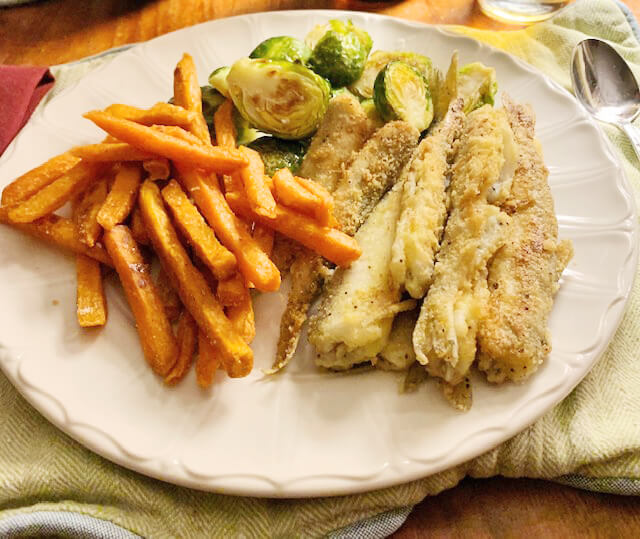Good taste and poor ingredients
Thirty years ago, I was introduced to the sport of ice fishing by a chef at the restaurant where I worked. Some of you may fondly remember Perry’s Fish House on Shelburne Road, which was a part of Tony Perry’s group that included Sweetwaters and the Sirloin Saloon. Tony had a knack for hiring exceptionally talented chefs who may have been overlooked by the competition. One of them was Steve Osborne.

When I met Steve I was working as a host at the Fish House and writing culinary columns for Vermont Outdoors Magazine (another wonderful publication that fell prey to mismanagement). My job was to take wild game to a chef at a different restaurant every month and have them create epicurean masterpieces. I would interview them, document their recipe (which they created on the spot), pair it with a bottle of fine wine, take a picture, and sit down to consume the feast. I did this for 10 years and collected some remarkable recipes and learned volumes about wild game cookery. Now, if you do the math, that is 120 columns with recipes. And every one of them was worthy of recognition by James Beard. During that entire period, we found only one recipe that I felt was utterly, undeniably foul: perch roe. Ozzie and I started ice fishing together and tried several times to conjure a sauce, spice or herb to cover the taste.
We started fishing together when he sold me an old 1979 Jeep CJ-7 for $700 “as is.” It had some unique characteristics—the two rear panels were held together by a long-threaded bolt that ran from the outside of the right rear quarter, through the back seat which we removed, and through the left rear quarter to the outside. On the outside of the box, I used heavy-duty stainless-steel nuts to keep the box from falling off. At one point, part of the exhaust system rusted and fell off on some dirt road in the backcountry. We needed to find a way to keep the exhaust fumes from entering the cab, so true redneck jury-rigging led a local unnamed gas station to use hose clamps to attach four Coke cans in line to meet the flange at the muffler. It had another unique feature we added while trying to solve the hole in the driver’s side floorboard. As we had begun ice fishing regularly together, making weekend jaunts to Mallets Bay in pursuit of yellow perch—and while I would never recommend driving a truck or car on the ice, when I considered the intrinsic value of the vehicle, it just made sense rather than walk a half mile onto the ice dragging a sled and buckets of tackle.
Now before I share the highly technical modification, it is important to note that in the 90s we used wooden hand lines with nylon line, a bright silver “flasher” and two hooks baited with minnows. The hand lines were rather short—only about 10 inches in length—thus. they were jigged close to one’s body. Most old timers would agree that those days were a lot colder than what we experience now, and when we put our collective ingenuity together it led to the first “fish-through-the-floorboards” prototype. We cut a square out of the hole in the driver’s side floorboard and attached a door with hinges that allowed us to drop a line right through the floor and into the hole we had augured below.
Now, back to the story of the inedible perch roe. We learned to clean our fish from a legendary commercial fisherman out on Porter’s Point named Ralph Learned. Ralph taught us to clean them so that the finished product was two pieces of meat with just the backbone and tail still attached, The Old Timers dubbed this method “crispy tails.” No ribs, no head, gills or skin, just meat, backbone (which peels away quite easily from the flesh when fried) and the tail. Now anyone who has had crispy tails will tell you that the tail is the delicacy. But for the hard-core “real Vermonter,” they swear that the female’s egg sack, called “roe,” when fried, is likened to an extraordinary french fry.
Well, being the outdoorsman that I profess to be, and believing that if you are going to kill something you should use every part of it that we can to honor its life. This is where I have failed to live the values I profess. Ozzie, being the master chef that he is, tried every way he could think of to make this roe palatable. Now, at Perry’s Fish House, once a year, when the shad ran up the Connecticut River, the executive chef of the group, Rod Rehwinkel, would use his local buying prowess to procure the shad roe. It would be on the menu every year for the select few who knew of its reputation as a rare delicacy. But try as we might, Ozzie could not create a recipe that made these fish (perch) eggs taste any better than rotten eggs. Be it known that I love caviar—beluga, lumpfish, salmon, sturgeon, any other roe from any other fish. But perch roe goes down in my book as the only entirely inedible perversion of wasted culinary talent.
If I were reincarnated as Anthony Bourdain, I might try it again, but for this lifetime, if any of my readers should want these despicable yellow sacks of foul-smelling eggs, please contact me, as I will be glad to set them on your doorstep for the remainder of the season.
Bradley Carleton is Executive Director of Sacred Hunter, a non-profit that seeks to educate the public on the spiritual connection of man to nature.

